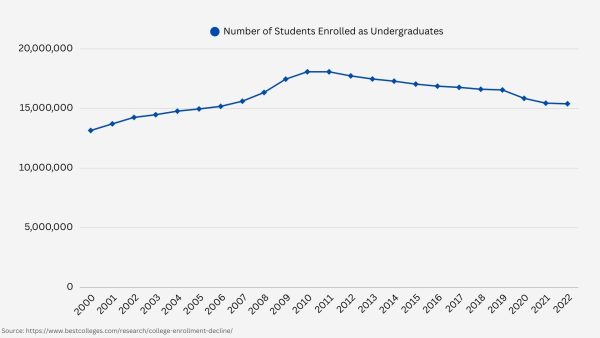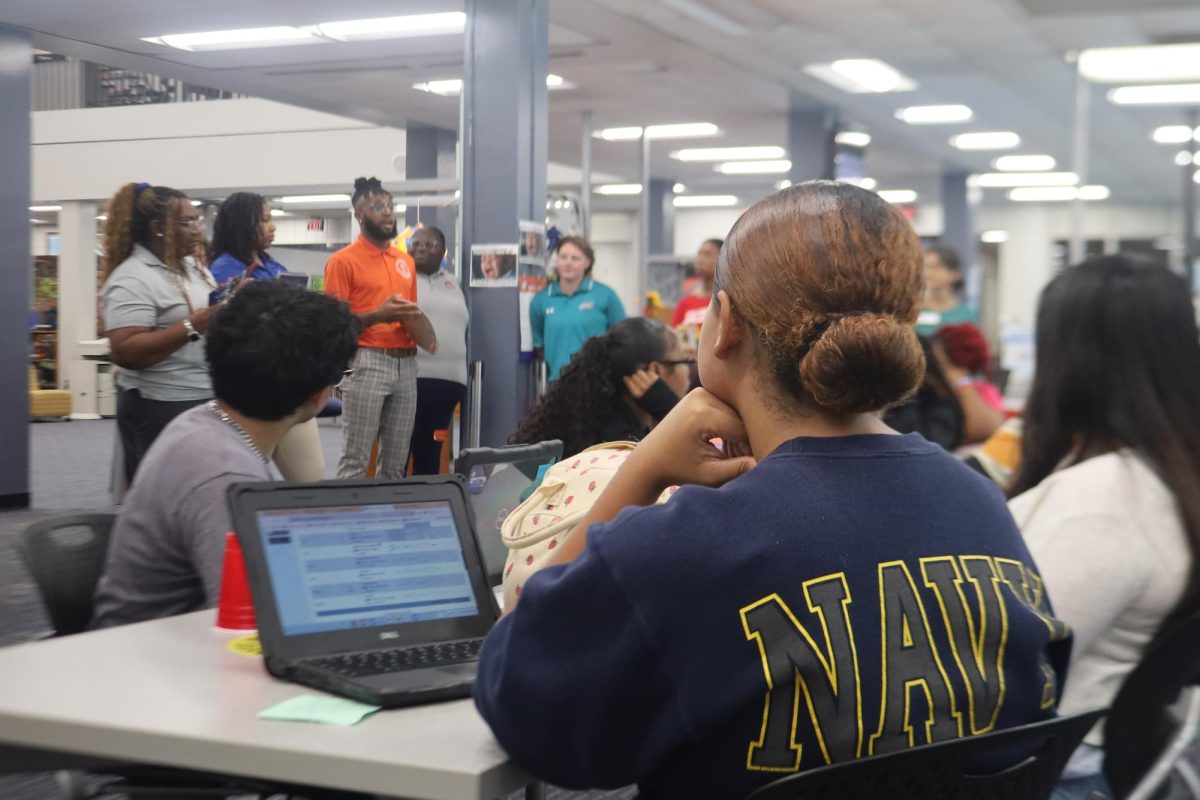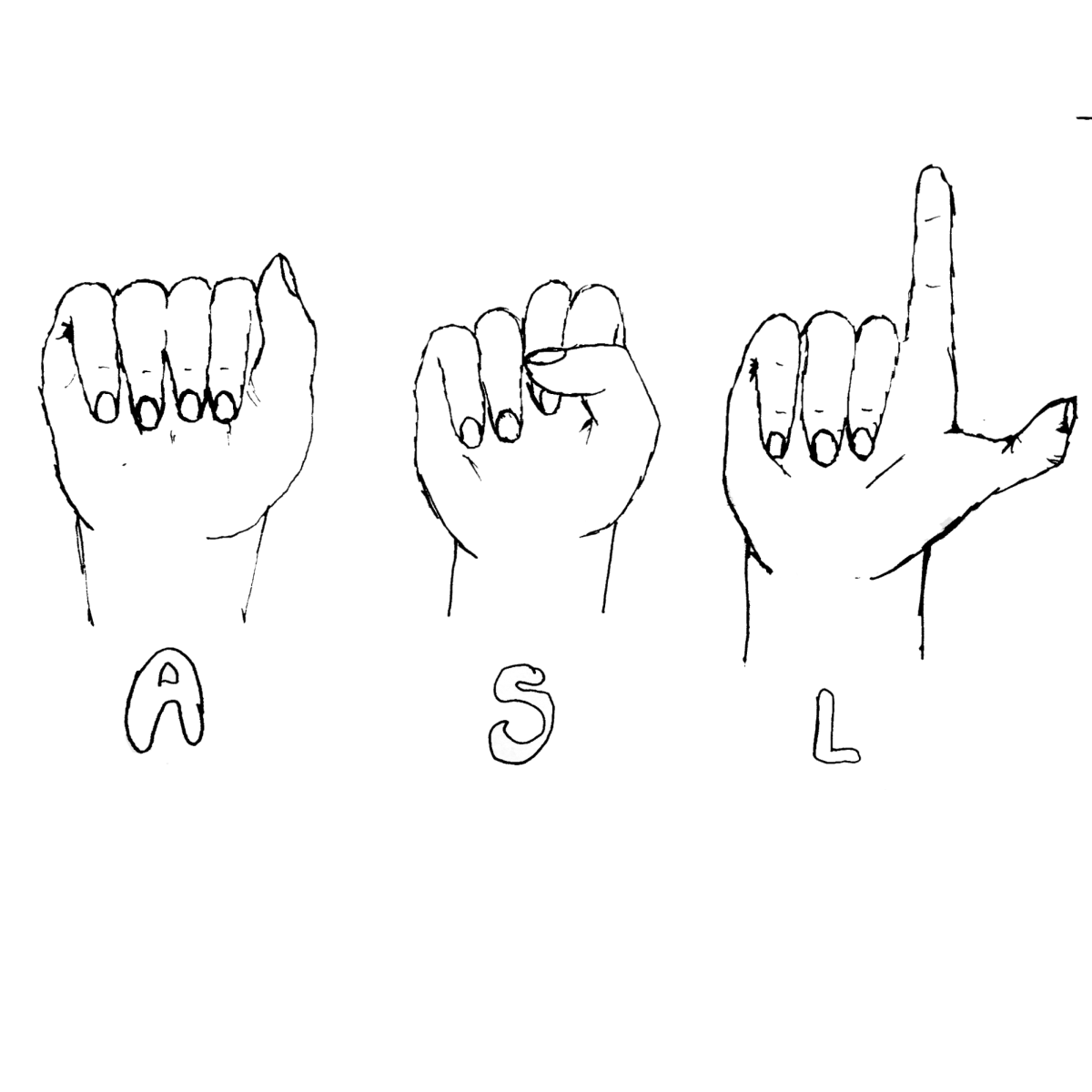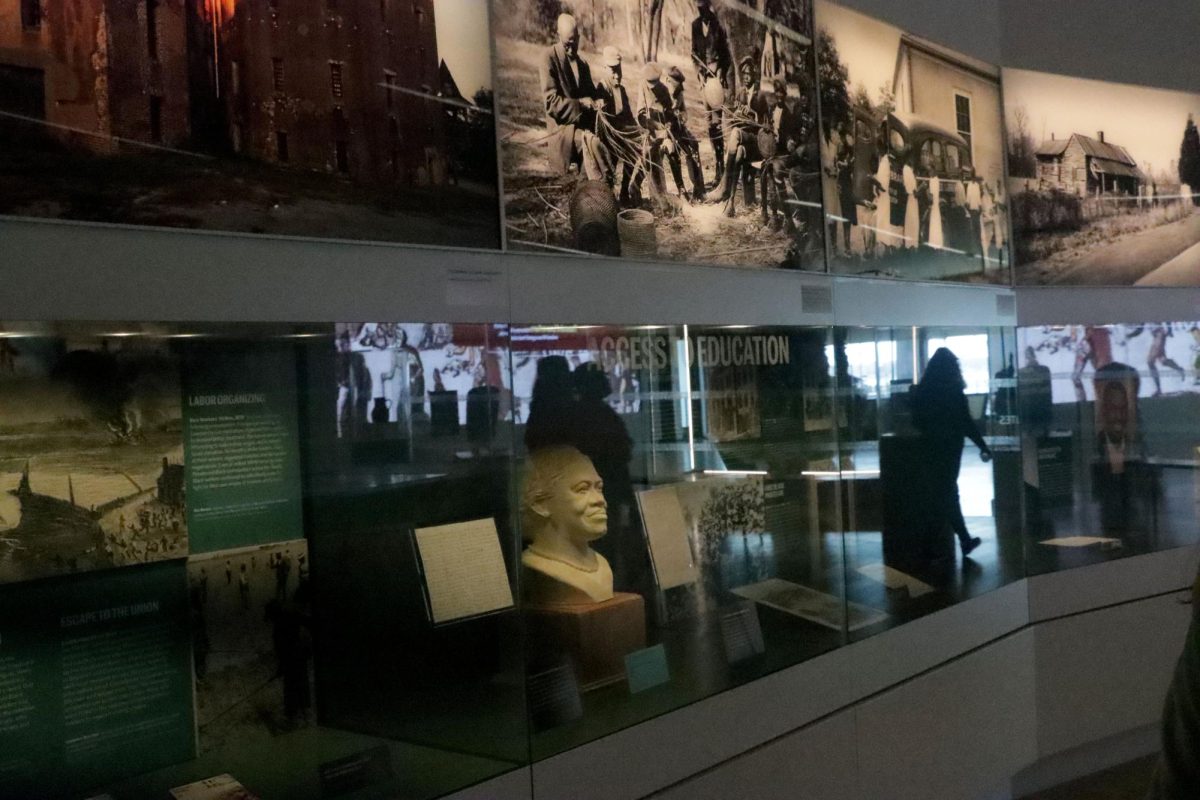Around this time of year, thousands of high school seniors across the country are finding themselves at the threshold of a new chapter in their lives as they prepare for college. Meanwhile, juniors are getting busy touring colleges and (probably, if they’re anything like me) feeling anxious about soon stepping into this new role themselves. Many students question where they want to go. Some question whether they want to go at all.
Since the beginning of the 2010s, there’s been a nationwide decline in the number of students enrolling in colleges and universities. After its peak in 2010, college attendance has fallen by about 15% on average as of 2022. That amounted to the lowest number of undergraduates in decades, no thanks to the pandemic.

While attendance was on the rise during the 2024 fall semester, another decline is predicted in the years to come – and this time, it’ll be even steeper than the last.
Experts say there are many reasons for the drop: more job opportunities available immediately after high school, higher costs of tuition, less motivation to get a degree and a general decline in the number of 18-year-olds. But the culmination of them all sparks concern across the board: fewer individuals going to school and getting degrees will affect the post-secondary education system, the workforce, and ultimately, society in general.
But if we wish to stop the drop, first we need to understand why it’s occurring. The most obvious may be the “demographic cliff” the U.S. is experiencing because of the 2007 Great Recession. Birth rates fell dramatically as a result of the economic decline, and 18 years later, fewer teenagers are coming of age and going off to college. This upcoming academic year, NPR notes, will be the last before a major drop occurs over several generations, with no signs of recovery.
That isn’t the only factor impacting the drop in enrollment numbers. There’s also the cost. College has always been seen as a sizable investment for many families, but what doesn’t help is the fact that tuition for four-year public colleges has risen 36.7% since 2010. That doesn’t include the meal plans, housing costs, and supply fees many students pay when they opt to live on campus. Even with financial aid and scholarships, it still amounts to a pretty hefty price tag. Not to mention private colleges, with their additional offerings and opportunities, typically charge more than state-funded colleges.
If they choose to go, many Americans are saddled with the burden of student loan debt after borrowing money to attend school. Approximately 43 million people owe money from student loans. The average amount of debt per person keeps steadily climbing, right now settling at about $41,618. Depending on how much someone owes (as much as $200,000), this could place them in debt for the rest of their lives.
The decrease in affordability has made the prospect of college nearly impossible for many low-income families, especially with inflation on the rise. As a result, many students are skipping higher education and going straight to the workforce, enabled by the rise of positions that don’t require a professional degree, only trade school and a license. Some of these careers pay pretty well: licensed nurses, for example, earn a median salary of nearly $60,000 a year, while plumbers and electricians can earn slightly more, around $61,500.
This could also be accomplished through degrees offered by community or two-year colleges, which are small, local institutions that offer associate degrees. These schools are typically less expensive than four-year institutions, and like trade schools, are closely linked with technical or vocational programs. Associates degrees are often adequate for reaching the qualifications needed for the technical careers and can be just as lucrative and cost effective.
Finally, the most recent obstacle to consider: the devastating effects of the pandemic on students then and even now. According to a study conducted by the ACT in spring 2023, the pandemic affected several high school seniors’ thoughts on their future careers, their intended major, what colleges or universities they wanted to attend, and whether they wanted to attend at all – one respondent to the study expressed that the pandemic negatively impacted their grades in high school, causing them to doubt “whether or not college was the best choice down the road,” they said.
Then again, the pandemic didn’t have only negative consequences. It gave some students, like former Tennessee high schooler Grayson Hart, the chance to explore paths outside of academia. While the pandemic closed doors for many people, Hart said that the free time he gained from virtual classes allowed him to strike out on his own. The skills he subsequently developed eventually landed him a job as a youth theater director in Jackson, Tenn.
Hart was admitted to every school he applied to, yet he turned them all down. His thinking, “‘Why do I want to put in all the money to get a piece of paper that isn’t going to help with what I’m doing right now?’”
In the wake of the aforementioned spike in non-degree jobs, PBS notes that there is a steep decline in many fields such as information technology and healthcare as a result. This is leading companies to offer “aggressively raised wages” as an incentive to get more people to work for them. But paired with the decreasing number of young workers as a whole, the impacts could be devastating regardless.
Decades from now, society may suffer as a result of fewer people who know how to work the middle-to-higher-income jobs that run society: fewer professors and teachers, fewer doctors. More students would have to learn through online classes, and we already know how that will turn out. More people would die of cancer or other diseases. The economy would tank because there wouldn’t be enough stimulation based on wage diversity. Our society would be weathered down, and there’s no telling how we would be able to build ourselves back up.
More immediately, fewer young adults would come to value the opportunities higher education has to offer. Going to college has given many people the ability to land good-paying jobs that boosted them and their families out of poverty. It’s given them the chance to experience things they never would have otherwise – research projects, field studies, travel abroad, internships, lifelong friends, lasting memories.
So what can we do to avoid this? Well, one thing that some Ivy League institutions have been doing to attract more students is making the cost of tuition free for any student coming from a lower-income household. Princeton recently announced that it would provide a completely free college experience for students from families earning less than $100,000. Harvard nearly one-upped them with their decision to provide free undergraduate tuition for students coming from households earning under $200,000, while they still implement the same financial aid as Princeton in terms of housing, meal plans, and other expenses. There’s still the question of getting in, of course, but for some students this will surely make a difference.
This obviously won’t be enough for the majority of American students, however. If you ask me, more public colleges should also try to lower their tuition costs, as Winthrop University did while many others raised theirs. This would open up opportunities for lower-income students who may not get into Harvard or Princeton with their grades, but are still academically capable and wish to pursue a meaningful career.
Schools providing general as well as emergency support could act as an incentive for students, ensuring that education will benefit them instead of being a hindrance even in times of crisis. As Scholarship America reports, this could mean the difference between continuing their education and dropping out completely: 95% of emergency aid recipients complete their current semester while 88% enroll in the next.
There could be more that the federal government could do to support more students going to college. For example, they could increase the amount of financial aid they offer with the FAFSA, or the Free Application for Student Aid. Especially with the recent dismantling of the Department of Education by President Donald Trump, more support in these uncertain times would be welcome by many. If politicians care about the country they run, they should care more about the futures of the future adults living and working in it.
More awareness about the FAFSA and financial aid could also be offered by high schools around the country. They could implement information sessions for parents and students, for example, much like RNE currently does. (Click on the above graphic to learn more about it!)
In general, high schools need to prepare their students for college and the adult world more than they currently are. One possible reason many students didn’t enroll in college during COVID-19 was that they did not have any guidance or support from teachers when it came to their futures. With the decline continuing long past COVID’s end, it’s obvious that some students still aren’t receiving the help they need. More field trips offering college tours, more exposure to potential careers and majors in the classroom, and more effort towards making students enjoy education would be a step in the right direction.
Thankfully, Richland Northeast already offers many of these opportunities. School counselors in the downstairs A Hall are readily available to help students discuss the paths they can pursue after graduation. We even have a college specialist, Cynthia James, who quite literally specializes in informing students about scholarship opportunities, college searches, and admissions.
In their own time, students could also reach out directly to colleges and schedule tours, request information, calculate costs and financial aid, and even take online quizzes to find out what major they want to pursue. While taking tours, they also might consider what kind of physical setting they want to live and learn in for the next few years. Big college or small college? Rural or urban? Public? Private? Community?
The search for the perfect college can be stressful at times, and it’s no wonder that more and more high school graduates are shying away from pursuing higher education. But going to college isn’t as impossible a feat as it seems, despite the circumstances. It’s okay to ask for advice and to feel unsure – at the end of the day, the most important thing is for students to know they’re on the path to a future best suited for them.










